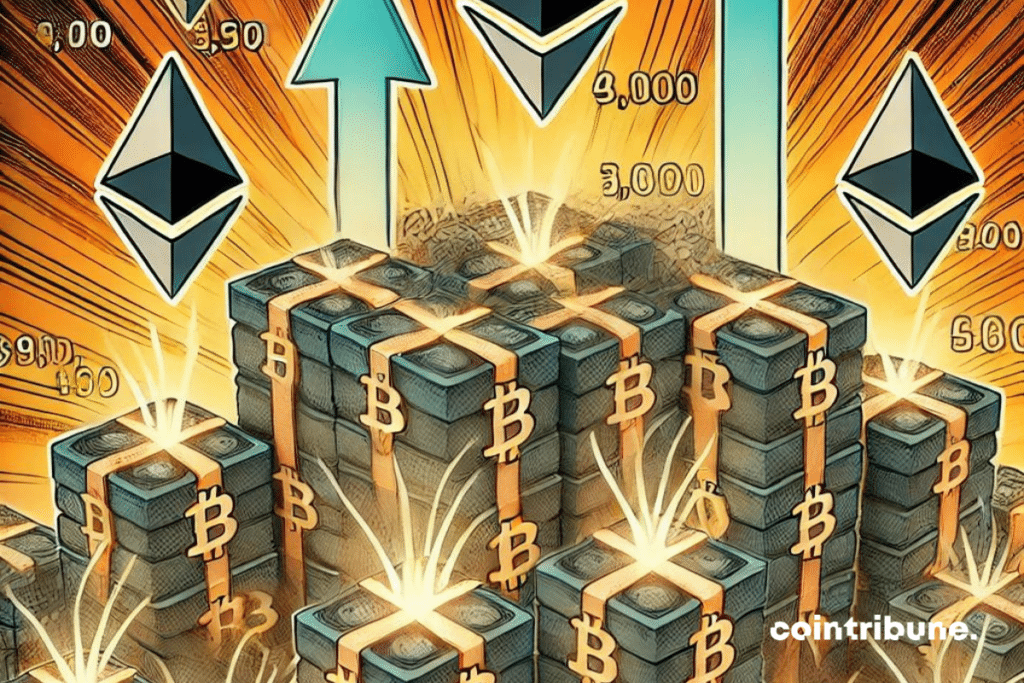7:00 am ▪
5
min reading ▪ acc
Ethereum, the second largest blockchain in the world, is back in the spotlight. As its network continues to gain popularity, particularly with the rise of decentralized finance (DeFi) platforms, a recurring problem is re-emerging: skyrocketing transaction fees. Indeed, with record volumes on Decentralized Exchanges (DEX) and an exponential increase in the number of active addresses, Ethereum is facing increasing congestion that is directly impacting its users.

Increase in fees due to unprecedented activity in the chain
Skyrocketing transaction fees on the Ethereum network are primarily due to the explosion of activity on the chain. The number of active addresses on Ethereum has increased by 29% in recent weeks. This increase in active addresses reflects the enthusiasm of traders and investors for DeFi applications and trading on DEXs. In addition, new addresses registered on the network increased by 43%, a number that shows the growing interest in the Ethereum ecosystem, but also increases network congestion.
At the same time, volumes traded on DEX platforms reached record highs. Thus, over the course of 24 hours, almost $978 million worth of Ethereum was traded on these platforms, with the weekly volume exceeding $8.38 billion. This intense activity leads to block saturation, which makes transactions take longer to confirm and therefore more expensive. Such a situation creates a dilemma for everyday users who find themselves in a spiral of ever-increasing gas prices.
Impact of staking and future prospects
In addition to the activity on DEXs and the growing number of addresses, another factor is leading to skyrocketing fees: staking. After a period of massive withdrawals during the last bear market, Ethereum bet flows are experiencing renewed growth. The data shows that the total amount of ETH staked has returned to its all-time high. After that, a balance between betting inputs and outputs is observed, reflecting investors’ renewed confidence in the network. This resurgence in staking results in additional transaction volume on the blockchain, which intensifies congestion and consequently transaction costs.
In the coming months, the increase in fees could have several consequences. In fact, it would discourage new users from adopting Ethereum, especially those making small transactions. Additionally, it could raise further questions about Ethereum’s long-term viability as an accessible and affordable network. However, with bull market expectations for the final quarter of the year, this trend could continue. If Ethereum fails to solve this gas fee problem, scaling solutions like Layer 2 or even competing networks will capture the growing share of users.
Rising Ethereum transaction fees are the price of growing success. The rise of staking and DEX combined with the growth of active addresses has created unprecedented congestion. As the ecosystem prepares for a possible spike in Ethereum prices, the question of the sustainability of these gas fees remains. The next few months will be crucial in seeing if solutions like sharding or second-layer networks can ease this tension and allow Ethereum to maintain its dominance in the blockchain market.
Maximize your Cointribune experience with our “Read and Earn” program! Earn points for every article you read and get access to exclusive rewards. Register now and start reaping the benefits.
A graduate of Sciences Po Toulouse and holder of the blockchain consultant certification issued by Alyra, I joined the Cointribune adventure in 2019. Convinced of the potential of blockchain to transform many sectors of the economy, I made a commitment to raise awareness and inform the general public about this ever-evolving ecosystem. My goal is to enable everyone to better understand blockchain and take advantage of the opportunities it offers. Every day I try to provide an objective analysis of current events, decipher market trends, convey the latest technological innovations and put into perspective the economic and social problems of this ongoing revolution.
DISCLAIMER OF LIABILITY
The comments and opinions expressed in this article are solely those of the author and should not be considered investment advice. Before making any investment decision, do your own research.

